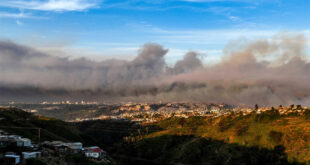For the second time in three years, no red-crowned crane wintered at the Tram Chim National Park in the Mekong Delta.
The park in Dong Thap Muoi in Dong Thap Province is famous as a natural habitat for the large East Asian red-crowned crane, among the rarest in the world and classified as “endangered” by the International Union for Conservation of Nature.
The birds usually arrive from Cambodia in December and stay until May, when it is the dry season in southern Vietnam.
They come to forage and mate prior to the onset of rains and floods.
Until 1980 thousands of them used to come every winter, but in recent years that story has changed with only a couple of dozens visiting the park at most each year.
Last December none arrived just like in 2020, Nguyen Van Lam, the park director, said.
 |
|
A zone in Tram Chim National Park in Dong Thap Province where red-crowned cranes normally gather for food, May 2022. Photo by VnExpress/Ngoc Tai |
Spread over 7,500 hectares, Tram Chim is recognized under the Ramsar Convention as a wetland of international importance, the fourth in Vietnam, and 2,000th in the world.
The convention is an intergovernmental treaty that provides the framework for national action and international cooperation in the conservation and wise use of wetlands and their resources.
The Phu My Species and Habitat Conservation Area, one of the key sites for wetland biodiversity conservation in the Mekong Delta, one of Vietnam’s important bird areas and a part of the Kien Giang Biosphere Reserve, reported a similar situation.
Just a few cranes flew past this year and none touched down, Nguyen Hoai Bao, deputy director of the Center of Wetland Studies at the HCMC University of Science and a volunteer at the International Crane Foundation (ICF), said.
Last year three cranes had visited Tram Chim, he said.
This is evidence of the “serious degradation of the natural environment,” he said.
In the delta, the conversion of natural wetland areas into lands for rice cultivation and aquaculture and the overuse of chemical fertilizers and pesticides have destroyed the ecological balance, giving red-crowned cranes almost no chance to live there, he said.
Besides, conversation areas tend to store water to prevent forest fires, which has reduced biodiversity and kept away the cranes, he added.
 |
|
A flock of red-crowned cranes in Tram Chim National Park in 2016. Photo by Nguyen Van Hung |
Tran Triet, director of the Southeast Asia Program at the ICF, said, “technically, Vietnam now has no red-crowned cranes.”
This year some of them did fly to Vietnam, but only stayed briefly before returning to Cambodia, he said.
“Locals sometimes find dead cranes in their rice fields. They died of sickness, and it means the environment is having problems.”
According to the ICF, there are around 15,000-20,000 red-crowned cranes in the world, 8,000-10,000 of them in India, Nepal and Pakistan and the rest in Indochina.
But in Vietnam and Cambodia their numbers have fallen from 850 in 2014 to 179 in 2020.
- Reduce Hair Loss with PURA D’OR Gold Label Shampoo
- Castor Oil Has Made a “Huge” Difference With Hair and Brow Growth
- Excessive hair loss in men: Signs of illness that cannot be subjective
- Dịch Vụ SEO Website ở Los Angeles, CA: đưa trang web doanh nghiệp bạn lên top Google
- Nails Salon Sierra Madre
 VnExpress News The News Gateway of Vietnam
VnExpress News The News Gateway of Vietnam




